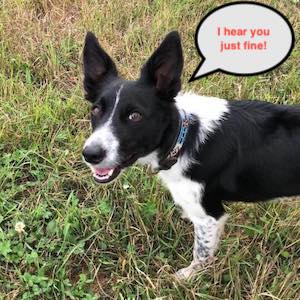
|
Tone of Voice
April 22, 2008
I thought I’d spend a little time talking about training voices. It’s something that people tend to not think that much about, but it’s very important to the dogs and really the first or second line of communication we have with them (along with body language).
When we start trying to use a whistle, we fret about how it sounds, about how consistent the tones are, sometimes we even record the whistle commands so we can practice and get good, reproducible sounds before subjecting our dogs to them. How many people stop and put this kind of effort into studying how they speak to a dog while working it? I honestly believe that a good part of the “presence” that experienced trainers have with young dogs is a well developed training voice. There are no magic phrases for dogs (they don’t speak English) but there surely are magic voice tones. An experienced trainer can walk into a field with a dog and by using only one word repeatedly (any word at all), used with appropriate tones and body pressure, have a dog behaving and working nicely. It’s all about how you say it, not what you say.
As for so many things when it comes to training dogs, our natural reactions are just the opposite of what we ought to be doing. When things get wild on the field, or our dog is gripping, running like a fool, generally just being a knothead, we start yelling in loud booming voices (men) or voices that rise in pitch at the end of a phrase (women). Both of these naturally wind a dog up and we’re putting pressure on our dog with our tone when he’s already feeling plenty of pressure (that’s why he’s being a knothead to start with), and we just make things even worse.
Stop to think about your tone in different situations with your dog, and try to give him as much help as you can so he can be successful. Say he’s going into a tight corner to pull sheep out. That’s a fairly stressful thing for most dogs, especially early in training. So as he starts into the corner, speak to him in a tone that conveys how you expect him to work – a nice, steady, confident, elongated sound. Try to do it *before* he gets wound up and worried, and just speak to him in a quiet tone that lets him know you believe he can do it, and that you’re there with him. Chances are, that little bit of soft tone will be just enough reminder to keep him quiet as he works. If you have a dog that’s a little soft, always speak in really confident bold voices. Try to avoid fast, excitable tones with a too fast, too excitable dog.
The best advice I can give when it comes to voices and working dogs is to stop and think about how the dog perceives what you’re saying, what message he is taking from your tone of voice. Speak in a voice that reflects what you expect from the dog. And if you need to use a voice correction, stop to listen to yourself and see if your tone is one that might be actually making your dog worse instead of better. Consider videotaping your working session and listen to your voice, and watch how your dog reacts. Try on your dog’s ears for a little while and get inside his head.
Please do not distribute articles without permission.
Send feedback to RobinFrench@Handlerspost.com
Return to the Shoofly Farm Website
|